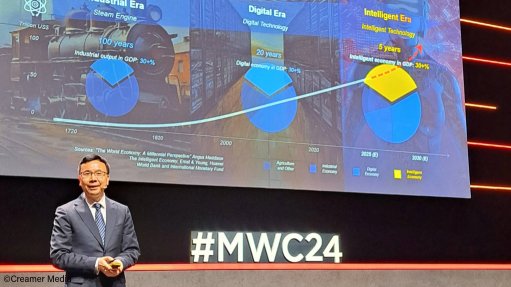
Huawei board member and ICT products and solutions president Yang Chaobin speaking at Mobile World Congress 2024
Photo by: Creamer Media's Natasha Odendaal
Information and communications technology (ICT) giant Huawei has launched the commercialisation phase of 5.5G.
Throughout 2024, the company aims to unlock the potential of networks and create new growth opportunities following the success of fifth-generation (5G) technology over the past five years.
"5G is on the right path to business success," said Huawei corporate senior VP and ICT sales and service president Li Peng, explaining that five years after 5G's commercialisation in 2019, it had already gained 1.5-billion users worldwide, compared with the nine years it took for fourth-generation to reach the same milestone.
Huawei board member and ICT products and solutions president Yang Chaobin highlighted, at a launch event at the Mobile World Congress, in Spain, the world's rapid move from the digital era and into the intelligent era.
Speaking at the company's 5.5G launch, he noted the 100 years it took the industrial era to add 30% to global gross domestic product (GDP), compared to the digital era, from 2000, taking 20 years to achieve that same 30% addition to GDP.
The intelligent era, from 2025, is expected to take just five years to reach the same contribution.
As the first year of the commercialisation gets underway, 5.5G is expected to contribute to the rising intelligent economy, boosting the continuous innovation of technology that has improved carriers' network productivity over the past 30 years.
The new transformative capabilities of 5.5G, including deterministic latency, precise positioning and passive Internet of Things, are expected to create even more opportunities for carriers in the business-to-business market.
Huawei Wireless Solution president Cao Ming pointed to ten times enhanced capabilities, with 5.5G offering 10 Gb/s downlink and 1 Gb/s uplink, as well as enabling 100-billion connections.
Commercialisation of 5.5G is accelerating globally, he said, noting that the Middle East was the first to commercialise at scale. There were 5.5G benchmarks across regions in Europe, Asia and Latin America, and China was now ready to commercialise across dozens of provinces and municipalities.
As 5.5G, artificial intelligence (AI) and cloud converge, carriers can unlock the potential of new applications and capabilities, said Peng, adding that carriers worldwide should focus on high-quality networks, multi-dimensional monetisation, emerging services and generative AI to leverage these opportunities.
High-quality networks remain the foundation of success, with the traffic generated by mobile users expected to significantly increase, allowing carriers with strategic goals incorporating the construction of high-quality 5G networks to maximise the value of traffic.
Currently, 20% of global mobile subscribers are using 5G, generating 30% of all mobile traffic and contributing to 40% of mobile service revenue, Peng said.
Further, 5G has also been adopted among many industries and, in China, for example, more than 50 000 private 5G network use cases have entered commercial use in over 50 industries.
While the foundations can be further maximised, new emerging services enable long-term sustainable growth.
"New Calling, cloud phones and glasses-free three-dimensional are getting more and more attention from consumers. For example, New Calling's value-added functions like virtual avatars are becoming quite popular. Users are also willing to pay more for services that deliver real-time experience, such as one-stop car insurance claims."
This emerged as generative AI drove the mobile industry into the era of all intelligence, with next-generation AI phones having more powerful storage, display and imaging capabilities, Peng said.
The AI-generated content applications powered by these phones will generate hundreds of billions of gigabytes of data and create new opportunities for carriers.
Global AI mobile phone shipments are forecast to reach 170-million in 2024, accounting for 15% of all smartphone shipments, according to the IDC.
*Natasha Odendaal is a guest of Huawei at the Mobile World Congress 2024, being held in Barcelona, Spain, from February 26 to 29.